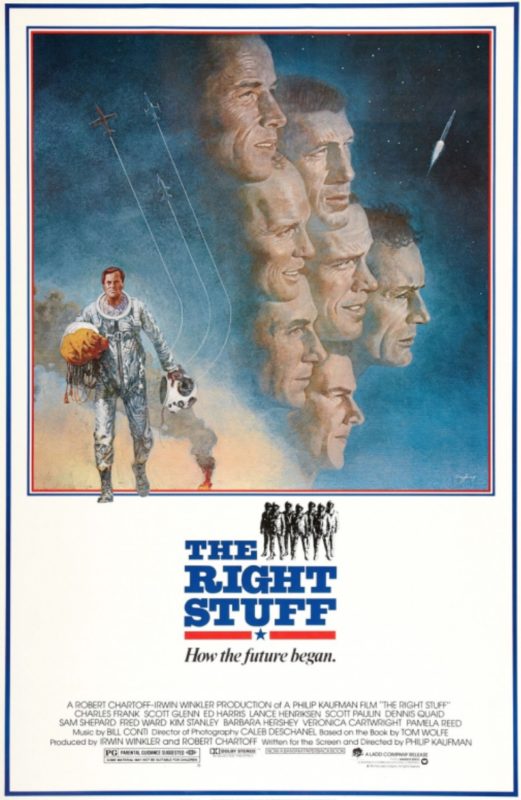As part of my efforts to share the experience of some veteran film editors, this week I’m honored to interview editor Steve Rotter, who was nominated for a BAFTA for sound editing on Dog Day Afternoon – a film edited by his mentor, Dede Allen. He won an Emmy and an ACE Eddie for editing the TV series Holocaust. And was nominated for an ACE Eddie and won an Oscar for his editing on The Right Stuff.
In addition to these award-winning films, he edited The Missouri Breaks, The World According to Garp, What Women Want, Enchanted, The Parent Trap, and Dirty Rotten Scoundrels… that’s just some of his filmography that includes more than 45 films, TV shows, and documentaries.
This interview is available as a podcast.
(This interview was transcribed with SpeedScriber. Thanks to Martin Baker at Digital Heaven)
HULLFISH: One of the things that I noticed about your background is that you worked for Dede Allen as an assistant. That was a fantastic way to start your career, I’m sure.
ROTTER: It may have been the most exciting day I’ve ever had in film — was the day that she hired me.
I was working around the corner from her on a documentary with an editor named Zina Voynow who was a friend of Dede’s and a legendary New York documentary editor. I guess Zena must have talked me up to Dede because when the job was over and I was cleaning up — I went out to lunch and when I came back there was a note on my synchronizer, please come see her.
So I went to see her and she said, We have a job opening and it would be as Jerry Greenberg’s assistant under her, and would I be interested? I just couldn’t believe it. It was the greatest thing. It probably was the best day I ever had in film.
HULLFISH: And Dede had that reputation at that point already?
ROTTER: Yes, she had already done Bonnie and Clyde and quite frankly, probably was considered by many the best there was. We became — not only colleagues — but very good friends and she pretty much taught me everything I know and also what not to do.
HULLFISH: And what is there not to do as a film editor?
ROTTER: Sometimes you don’t want to present the director with too many choices otherwise they can’t make up their mind.
She would always say, “Well, if you don’t like this, look at this. And if you don’t like that, look at that.” So I sort of ‘skinnied’ it down a little bit.
She was devoted to taking care of her directors. She would make them food. Her whole being was devoted to that particular director, whoever it was that she was working with. I didn’t quite go that far.
HULLFISH: You’re not cooking for people?
ROTTER: I’m not cooking for anybody.
She was extremely talented. At the time, it was not only myself, but Richie Marks was working for her. He was above me. He was her direct assistant. Later on — when he left — I then graduated to become her main assistant.
She also pushed me out — gave me jobs with her as second editor — and then eventually I was able to get my own jobs — a few of them with her recommendation. It was just a miracle.
HULLFISH: I also noticed that you worked as her sound editor for at least one job right?
ROTTER: I did. I worked as a looping editor for her on a few films and then she was working on Sidney Lumet’s Dog Day Afternoon and my wife was about to give birth. So after my wife gave birth she asked me if I would come on and do ADR for that particular movie.
So needing the money and having a newborn I took that job. It was fun. And I remember that my assistant called up my wife begging her not to have me take the three o’clock feeding because I was getting too mean in the cutting room.
Dede was my champion all the way through. We lost someone special when she died quite a number of years ago now.
When her mother would come to town, that was the only person that could tell her to come home, otherwise, she would hang out in the cutting room working like crazy until at least 10:00 at night. But when her mother was in town, she’d leave early.
HULLFISH: Working with Richie Marks — another guy that we lost too soon, too.
ROTTER: I know. He actually was my very best friend in the business. We had the same work ethic and we had the same opinion about things and I miss him dearly and think about him almost every day.
HULLFISH: Let’s talk about Dirty Rotten Scoundrels. When I watched that again I could definitely see why that was one of your choices for me to watch before we did this interview.
ROTTER: First of all it’s one of the funniest movies I’ve ever seen. Second of all, I did three movies with Steve Martin and he is an absolutely brilliant actor. He moves well. He performs perfectly all the time. He makes it really easy to work on his movies.
The interesting thing about that movie was that there was a writers’ strike taking place and they had no ending to the movie. So director Frank Oz and Steve — and maybe there was another person involved — they concocted the ending to the movie and it worked unbelievably well.
Some of the funniest scenes that I’ve ever seen are in that movie. It’s just a phenomenally funny movie.
We also finished it really quickly. It was shot in the south of France. It just went together like a charm. Chris Rock once said to me there are two kinds of directors of comedians. One is a jockey, that rides the comic’s performance and the other type actually writes and is funny themselves. Frank Oz had a good deal of both of those, so it’s no wonder that the movie was as funny as it is.
I just remember that when we had test screenings it was just so much fun to be in the audience because they were laughing so hard. There’s nothing worse than being in a test screening when they don’t laugh. Test screenings are like final exams that can ruin your life.
HULLFISH: And you can’t cheat on them.
ROTTER: You can’t. Richie Marx once said to me when he was in a screening and people were walking out, he turned to his sound editor and he said, “I feel like I’m attending my own funeral.”.
HULLFISH: You didn’t start out editing comedy. Comedy is not easy. How did that transition go when you went from more dramatic films to comedy? Is editing just editing, or is there a difference?
ROTTER: I actually don’t think there’s a big difference. I once had an interview with a director who said he was a little worried about the comedy. “How do you know when something is funny?”
My answer was, “It’s either funny or it’s not.” Needless to say, I didn’t get the job, but I kind of believe that. With something like Dirty Rotten Scoundrels, you couldn’t help but be funny with that movie.
There are all these theories — do you pause for laughs? Do you make a reaction shot longer? I feel like you just sort of have to have the rhythm of the scene. You have to stick with whatever the rhythms the actors give you.
Dramatic films are somewhat the same. Literally, with most movies, it’s the performances that’s the most important thing. So the more you dig and the more you get as best of a performance out of that particular role the better off you are.
So I think your goal is — at the end of whatever movie it be, a comedy or a drama — is to really believe that it’s the best film that it could be with the material that was given. When you’ve done that and you can actually think that way, it’s extremely satisfying.
HULLFISH: One of the things that I noticed as I was watching the film — it’s shot like a lot of classic comedies that use medium two-shots instead of cutting back and forth a lot. It wasn’t a lot of close-ups. It played things out wider where you could see the interaction. It was Michael Caine and Steve Martin — so you could see them both together in the frame at the same time.
ROTTER: In that particular case I believe that was the directorial decision. I’m not sure that there were close ups of those particular scenes that played in two-shots. Seeing them together was priceless.
There’s a scene by the pool where they’re sort of strutting around that’s extremely funny. I believe there are a few singles but not that many. So a lot of these editorial choices really rely on what the director intended and what he gave. It’s not to diminish the contribution of the editor, it’s just to say that you use what you have.
HULLFISH: Another scene like that was the scene where Michael Caine’s character visits Steve Martin’s character in a jail. I don’t remember it perfectly, but it’s almost done as a oner.
ROTTER: I believe there’s some coverage through the bars back and forth, and then the policeman standing on the left, but once again how can you go wrong staying on Steve Martin? It’s absolutely hysterical.
Michael Caine was a very nice man and he always used to ask me, “How am I doing?” I was stunned that he would ask that question. The two of them together were just beyond belief.
HULLFISH: I don’t know whether people think about this who aren’t editors but there’s a great montage that you did in that movie to Puttin’ on the Ritz. What was that scripted as? I got in touch with the original scriptwriter of Dirty Rotten Scoundrels and he sent me the script for that scene and there’s not a lot to go on.
ROTTER: No, there’s none in the script. It’s all the director and the music that was chosen to do it. They probably played that music back on the set because if you see their movements it’s really choreographed.
The writer was a really sweet guy and he would bring extras to the set that he found on the beach.
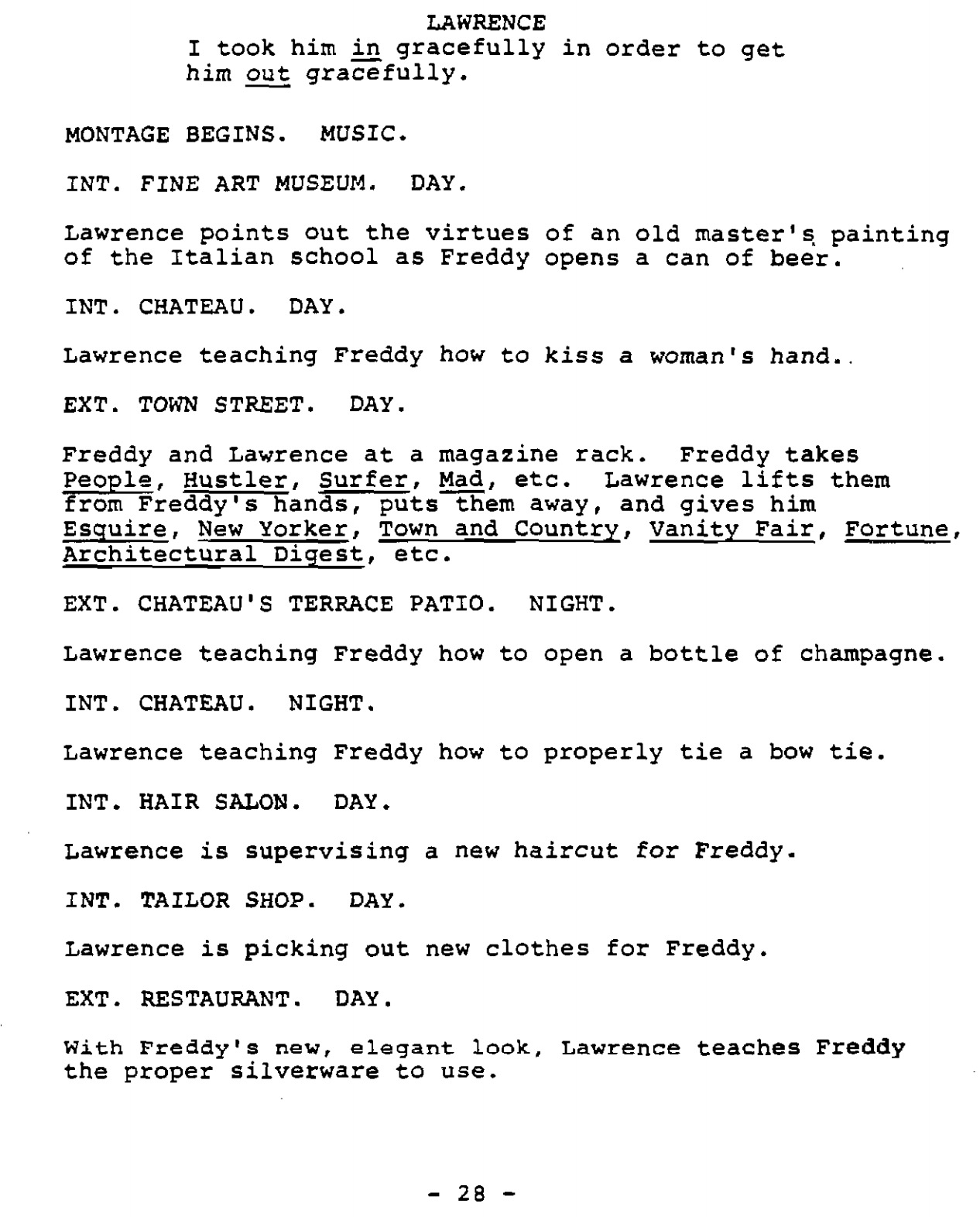
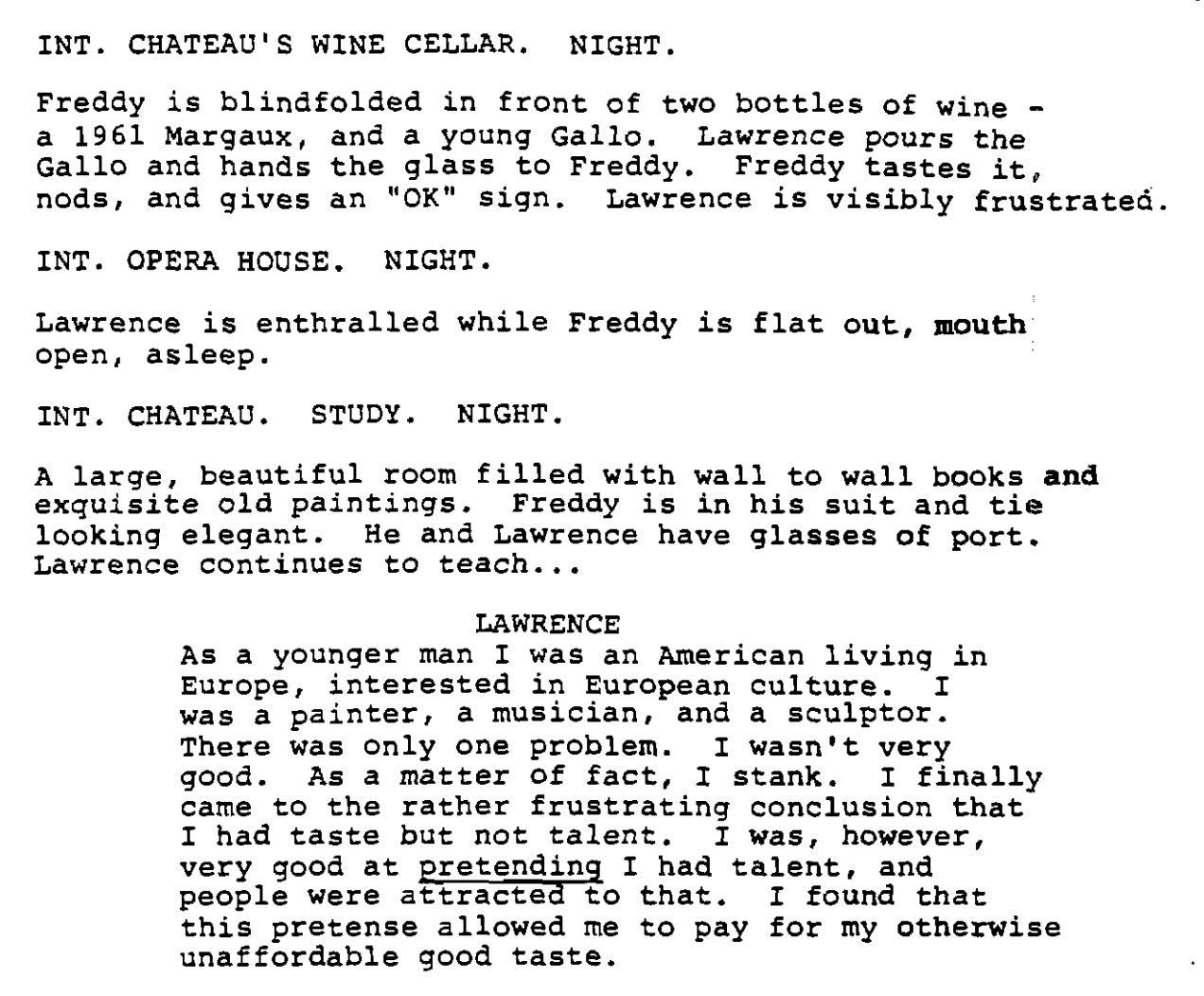
HULLFISH: There were a number of places that I loved where you know that some significant amount of story plays out between edits. Like there’s a moment where Steve Martin is heading back to the United States in defeat on an airplane and he meets one of Michael Caine’s scam targets. Basically, as soon as Steve realizes the scam, it basically cuts right back to him arriving back to re-visit Michael Caine even though there had to have been significant time and story that plays out between the edits. The audience knows what happened without having to see it play out.
ROTTER: Exactly. It kind of jumps you forward in a way. There would be no resolution to that scene anyway. You just jump out of it. I think there were a few instances of that.
HULLFISH: Absolutely. You don’t have to tell the audience — you don’t have to explain — “He figures the scam out. He comes up with a plan. He executes the plan. He comes back.” You don’t need any of that stuff.
ROTTER: Right. Particularly if their performance is just outrageous. Then, of course, there’s no need to explain anything because you understand from the characters what happened.
That was a very difficult scene to put together. Steve was kind of freaked out about the actress he was playing against.
HULLFISH: What do you attribute that to? The fact that the actress was wacky or that there wasn’t a lot of blocking space in a tight airplane galley?
ROTTER: It definitely has to do with — she was all over the place, trying different things and some worked, some didn’t. You had to pick and choose. My memory is a little hazy. I just remember it being extremely difficult.
HULLFISH: Let’s talk a little bit about the Oscar-winning The Right Stuff. The top of that movie is a lot of montage with the X1 experimental super-sonic jet. Was that production footage or was that actual archival footage of the X1?
ROTTER: That was a little bit of archival footage but mostly special effects and throwing things out the window and being in the cockpit with him and having texture behind him.
They had an experimental filmmaker named Jordan Belson (credited as Special Visual Creations) did all these liquid crystal things. They put them behind their head when they were in space so when they fly the X1 these crystals are suggesting that he’s in another dimension almost.
They shot special effects almost every day of the movie. I edited that particular scene and I scoured months of special effects for that particular scene of things that had been discarded that I wanted to go through and see if I could use pieces — which I did.
When I came on the movie the scenes consisted of being inside the cockpit and then outside for what seemed like less than a second. So was really choppy. And so I thought that if I would take two or three of these actual passes of the X1 — which were special effects like CO2 cartridges up this little model or whatever it was — and put them together with a single pass sound effect it would sound and be better and that’s exactly what happened.
If you watch that particular scene, whenever you cut outside, there are at least three or four shots of the airplane going in one direction — it balanced a little bit better. The director was sensational — Philip Kaufman — I don’t know how he thought up these things or how he did it, but you dealt with performance, texture, colors.
Things that you never deal with in other movies existed in that movie. Never again did I have the opportunity to work on something that had so many elements. In many ways, it was definitely the highlight of my career.
Besides myself, there were also a bunch of other editors on it who were really also quite accomplished. It was a once-in-a-lifetime project.
HULLFISH: What struck me with the X1 sequence was that you have to show the speed of the aircraft — that it’s going at supersonic speed — but as you point out, that means it goes past the camera in just a few frames.
ROTTER: Exactly and that’s why two or three or sometimes four of those shots that went through the frame in less than a second were put together to at least give you enough frame of reference to not blink and lose it.
It was seat-of-the-pants special effects — no computer animation. The plane had no shake to it and it just was like a dart. It didn’t seem real. Then combined with the background and the sky turning different colors due to this liquid crystal photography, it truly was amazing.
If an editor was to hang his hat on one sequence that would be mine. You have the people on the ground that are watching. It was quite a wonderful piece of directing. In some ways the editing part was lucky. You have this idea and it worked.
HULLFISH: The editing definitely makes that sequence, and it’s fascinating to hear you say that you needed to use multiple shots with the same audio to bridge it because one shot is not enough, but multiple audio cuts would also be a problem.
ROTTER: Exactly. If you change the audio for every one of those little shots it would make it like chopped meat.
With Phil, there’s not too much deviation from the script ever because there doesn’t have to be.
And exception would be that there wasn’t much scripting to the intercutting of the Sally Rand fan dance. That’s something that you can’t script. You have to sort of go by instinct. But the concept is there. All of those flights — Glenn’s flight where you have both stock footage and production footage.
The concept is there, but there’s a certain freedom that you have to use to put it together because there’s no way that you can tell how it goes unless you actually do it.
HULLFISH: One of the things that I loved about The Right Stuff was a sense of dynamics. Can you talk about crafting peaks and valleys?
ROTTER: In that particular movie, the actual flights and the action — because of the feeling that you wanted to get while you were in space — couldn’t be loud enough and then all of a sudden it would shut down when you got to the ethereal part and there’d be nothing.
So it was by design — Phil had real specific sound ideas and Jay Boekelheide, the supervising sound editor pretty much adhered to them and did a beautiful job in crafting those sequences. But it’s really about the scenes themselves. What scene demands a louder perspective and what scene is more intimate.
There’s a really great use of music in that movie particularly when the astronauts walk out. A very heroic moment. A very heroic piece of music that Bill Conti did. It was stirring. Almost patriotic.
HULLFISH: This was cut back in the days before non-linear editing. How much temp music was used when you cut on flatbeds?
ROTTER: As much as you could put in. We had a temp music editor. You’d cut a scene and she’d add the music. We’d do these little temp mixes on KEMs. Sometimes we’d have a screening coming up and the KEMs would be going 24 hours a day, so I would be told, “Come at 2 am and we’ll do this scene.” Susan Crutcher was the Source Music Editor and she came up with songs like with Dennis Quaid there was a song: “There’s a Rocket in my Pocket” which I thought was brilliant.
You’d do the sound effects and sometimes some of the assistants would do them. On the KEM you’d have, like five tracks and sometimes you couldn’t mix them all. You’d have to premix them. And of course, I would just be sitting there watching at 2 in the morning.
When we came to the final mix it was Mark Berger — who was absolutely a sound guru and genius. It was an amazingly long mix. It seemed to me to take months. Then when we were finished no one really had seen the film in its entirety in quite a while and we took it to a theater in San Francisco and ran it and it was like a miracle. It all worked.
Phil liked to limit his exposure to the film in its entirety so he could have a fresh eye when he ran it. And so his theory worked. It was an “Oh my God moment.” Wow.
Now, of course with digital editing you can add the music and the effects all at the same time with just the push of a button. Back then it was like, you have to build the track and hump the stuff over, so it was a lot more complicated. But I think the outcome was sometimes even better because I think that the electronic editing seems to lend itself to quicker cuts in many instances. And so sometimes you’re left a little baffled or wanting more.
There are some really great films edited electronically, and I, of course, at the end of my career used electronic editing.
HULLFISH: Nowadays when you work with multiple editors you’re on an Avid and you’re on a Nexis or a Unity or something and you can all see each other’s stuff. How much were you able to share each other’s work back then as multiple editors?
ROTTER: Whenever anyone would cut or redo a section, we’d all get together and screen it. Everybody would offer an opinion. There seemed to be a bit of a rivalry there where some people’s opinions weren’t appreciated as much.
In those days I was a little bit more competitive than I was at the end of my career, so I took umbrage at some of those comments but some of them actually worked. But it wasn’t a happy time.
HULLFISH: So a little competition going on during screenings. I’m assuming that was in a dailies theater or something? You weren’t all hunched over somebody’s KEM?
ROTTER: No. They built their own little theater — that wasn’t so little — in a factory building in San Francisco and it was like a family. There was a shower there and an aerobics instructor would come in. Everybody would stop for aerobics. It was really like a Japanese factory.
HULLFISH: How long did that go on? Do you remember what the schedule was like for that — from dailies to delivery?
ROTTER: It had to be at least 18 months, but I only know the part that I was there for.
HULLFISH: With the space flights, I was thinking about the challenge of trying to build to a crescendo without overusing or re-using certain shots. Or saving up super-cool shots or angles or effects for certain key moments.
ROTTER: You have to build to a natural sort of high point. If you make too much of the beginning then you’ve got nowhere to go. That film got a lot of acclaim, but the director didn’t get that much. I think it was a huge mistake that Phil wasn’t recognized for his contribution. He was the architect. He was the builder. He did everything.
There were many films that won Oscars after that based on the same subject and they keep doing it. Now there’s going to be a television series on The Right Stuff. The original is still the best as far as I’m concerned, but then I’m prejudiced.
HULLFISH: You mentioned the dance scene. That scene is intercut with space flight. And there was a thing I loved where the parachute deploys and there is no sound.
ROTTER: Right. That wasn’t an editorial choice. That would be an artistic choice by the director and the sound editor.
HULLFISH: Throughout the film, there’s the occasional use of pre-laps. What do you use those for? What is the value of doing a pre-lap on an edit?
ROTTER: I’m not exactly a proponent of that. However, what it does is that it thrusts you into the next scene, particularly when the transition is not the greatest.
It works, and so the best thing I think you can say about a pre-lap is that it works.
HULLFISH: I interviewed Walter Murch and I think he feels similarly to you. He told me, “I think pre-laps are like blowing smoke over a transition.”
ROTTER: Yes. I’m making the same point. I’m not quite as articulate as Walter Murch.
HULLFISH: Who is?
One of the first movies I think I ever saw that you cut was “World According To Garp” which I just love. That has some animation in it. Do you remember whether you had to do some storyboards there? How did you deal with the animated sections of Garp?
ROTTER: Actually John Canemaker was the animator. It was scripted that way. I don’t remember any kind of previs of animation. I just remember him delivering it.
HULLFISH: Wow.
ROTTER: And it was fantastic. Since then, I have given lectures at schools where they showed that movie and for some reason, the animation was cut out.
HULLFISH: WHAT???
ROTTER: Yeah. That animation was amazing… and funny.
The opening of that movie is sensational. It’s one of the best opening scenes I’ve ever dealt with and one of the best I’ve ever seen. Hume Cronyn and Jessica Tandy are just phenomenal.
The concept of the baby floating through the air — they shot all this footage in a studio with a crane going back and forth and I said to (the director) George Hill, “It’s great! And the title sequence company will just deliver us the sequence? How fantastic is that!”
He said, “No no. You’re going to do it.” It was one of my first movies and I was a little bit fearful of that particular opening sequence. My reaction was, “What?” to myself. I don’t even know how to do that, but it worked out.
HULLFISH: Did you read the book? It’s based on a book.
ROTTER: I did read the book.
In this case, I think I understood the movie much better than I understood the book. The book just didn’t have the same impact on me as the movie did.
The cast of that movie was phenomenal.
Since it was my first movie I was semi-terrified the entire time. I managed to hold it together but there were nights when I would just lie in bed in a cold sweat and my wife would be asleep next to me and suddenly realize that I was in discomfort and she’d ask, “What’s the matter?” And I would say, “Oh nothing.”
Sometimes I would be stuck on a scene — and particularly as I got more experience — and so I would just go home. If it was eight o’clock, nine o’clock at night, I’d be totally stuck. I wouldn’t know what to do. I’d go home and suddenly — in the middle of the night — it would come to me.
I was never one to think intellectually about why you did something, but somehow, instinctively, I knew what to do in the middle of the night reaching a solution, so I couldn’t wait to rush back in and do it.
HULLFISH: I love that advice that you shouldn’t get caught up — if you don’t have a solution for a scene, leave it.
ROTTER: Yeah. Don’t force it. Boy, that’s the worst thing.
I remember when I first started editing. I was a second editor for Gerry Greenberg on something and it was tape splices. Every cut I would agonize over.
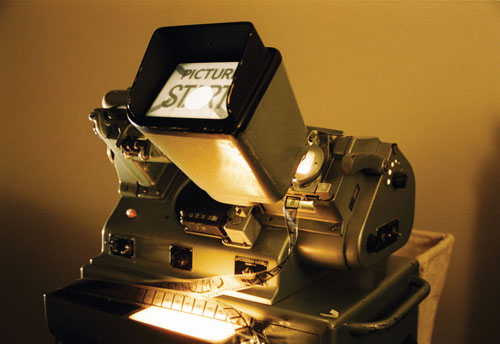
And when you would run scenes through a Moviola or a projector — and it would click or tick every time it hit a splice. So when I ran my scenes I was embarrassed because it was like a B.B. gun. tickticktickticktick.
Finally, I got accomplished enough so that it didn’t do that. And of course, when digital editing came in, you didn’t hear a thing. It was quiet. It was fabulous.
HULLFISH: How was that transition from film to digital for you and when was it?
ROTTER: I switched to Avid on Father of the Bride II.
I had a genius Avid assistant named Jimmy Durante — if you can believe that — and I kept him for the rest of my career. He could do anything — he nursed me through the whole thing.
So after a couple of months, I was pretty conversant with the Avid. I can refer to myself as a film terrorist. I could fly but I couldn’t take off and land.
HULLFISH: (LAUGHS)
ROTTER: I needed my assistant to take off and land.
HULLFISH: There’s plenty of film editors in Hollywood that that applied to.
ROTTER: I wish I knew how to do it all. It was too late for me in those days, but I always regretted not having been an additional assistant so I could have known what to do.
However, digital editing has taken away a big part of the training of assistant editors. I always used to say to my assistants in digital, “Please, whatever you do, take a scene, put it together, and let me see it. It doesn’t matter what scene it is because we don’t have to restore it.” (When editing on film, re-editing a scene would require undoing all of the splices and possibly making a film print of the original cut in case it had to be restored to its original state.)
But for the most part, they were so busy that they didn’t have time to do it — between getting the dailies ready, doing effects for me.
HULLFISH: Do remember the character of Poo in World According to Garp? Was there a bigger arc for her than what was in the film?
ROTTER: No.
George Roy Hill, one of the best directors ever. He had everything. He could direct actors. He knew camera. He was a live TV director.
We were kind of friendly, but then he never asked me to do another film after that, so I thought he probably didn’t like me. I think we visited after that, so I couldn’t explain it except that the film didn’t do well and maybe at that point, I wasn’t as skilled as I thought I was. The film was great, so I don’t know what the reason was.
Those things you have to overcome in a career because there are plenty of times that you’re going to have someone that you think is going to hire you that doesn’t.
HULLFISH: What are the relationships like between you and your directors? What are the politics? What do you think an editor needs to know about nursing that relationship with a director?
ROTTER: The most important thing is that when the director shows up every day that they’re happy to see you. That means that they like you. You’re there to serve them and to be their best friend and hopefully help bring the film to whatever vision they want to achieve.
You have to be a little bit critical if there’s something you don’t like. You have to speak your mind, but only once. Once is enough. You can’t keep harping on the same thing because they’ll start to resent it. Not unlike a cameraman. So when the director gets to the set they like to see this guy. You have to be likable. You can’t have a difficult personality that’s challenging people.
There are many editors that work on different levels. Their skill precedes them and they can be a little tough on some directors but I always found you had to be as nice as you could to everybody.
Most directors — when you were on a Moviola — they wouldn’t sit there all day. It was too boring for them. It would take so long and they wouldn’t be able to see more than one or two shots, so they would wait until things were assembled.
With the Avid, it’s different. They like to be there. They can try different things at the press of a button. Also, the studio can weigh in better — which is not such a great thing — when you’re on the Avid.
HULLFISH: Do you find that you need patience as an editor to get through the process?
ROTTER: The thing about an editor is that you can never give up. You just work as hard as you can and the day will pass like lightning. I don’t know that patience is the right word.
Sometimes I would come in at eight in the morning and at ten at night I wouldn’t even realize that time had passed except that someone handed me a sandwich.
HULLFISH: Hopefully two sandwiches in that amount of time.
My point with the patience thing is that when I was a younger editor I always felt like the first edit should be perfect and then it shouldn’t change. And now I realize that the process takes months and months and things change and they evolve and you have to have the patience to have the scene and the film evolve.
ROTTER: It’s true.
I’ll tell you a funny story about that. When I first started working with Dede, it was on Alice’s Restaurant. Before we showed (director) Arthur Penn the movie, we would run it for ourselves. I’d never been on a feature film before and I thought to myself, “Wow! This is perfect.”
Arthur came in and right from the beginning he starts to tear things apart and I think to myself, “How can he do that? It’s beautiful!” Then about 10 months later I realized that he was right. This was the process. From that initial instinct about, “This movie is perfect” to how it actually ended up, taught me a very good lesson.
The only time that you really have to have patience is if there’s a scene that you particularly hate and the director keeps wanting to revisit it. Just when you think, “Oh thank heaven! It’s finished!” they’ll say, “Can we look at that again?” That’s when you need patience. It’s those things that you know are going to be the death of you, and they keep coming back until you think you’re going to scream.
One of those occurred really early on in Alice’s Restaurant was all the Pete Seeger scenes and I’m not a big fan of that kind of music, to begin with. I was the assistant and we kept having to dredge the scene back again and then we were miserable. To this day I remember the song.
HULLFISH: Do you remember learning something from Dede about having her scenes ripped apart?
ROTTER: It was a good lesson because she had no problem with that. All her directors were like her heroes. And she was their hero in many instances.
She expected it. And it was a matter of fact. Sometimes she would think that had done something wrong that they shouldn’t have done it, but very very little. It was part of the process. She recognized it as part of the process.
She used to talk through everything while she was working. I’d be handing her pieces of film and she’d talk about every cut: “I should do this.” “Maybe I should do a close-up.”
No matter how long I stayed with her and watched her and learned from her, when you start doing it yourself it’s a whole different ballgame. No matter what, you’re terrible when you start — or at least was. Boy, it was a rude awakening.
HULLFISH: Helping to train an assistant is very different on the Avid because — in your example with Dede — you would never ask an assistant for a shot on the Avid. The editor can access any shot instantly, so the assistants don’t get to hear what the editor wants next and why they might want it or why it didn’t work if they ask you for another shot instead.
ROTTER: What I did do is that I would show my assistants each scene to see whatever their comments would be. Sometimes I would ignore them and sometimes I would implement some of them.
On film, you’d have to take copious notes because it was too hard to go through each roll of film to find what you wanted. In the Avid, you can look at each scene for that section in no time.
Nancy Meyers once said to me that she admired the way I used behavior in my editing because I would look for moments of behavior in the dailies that I could incorporate — not only with their reactions or dialogue but of like weird little behavior — that you could stick in and it would make sense and it would help.
On film, editors used to make select rolls and some of them still do in the Avid. I always thought that making a selects roll limited your options. That if you didn’t go through everything each time then you might miss a moment that — in notes — looked like it didn’t work, but perhaps in context, it would be brilliant.
HULLFISH: There are editors that like them and there are others that don’t.
Another movie you had cut was The Parent Trap. (The 1998 version starring Lindsay Lohan) Was that tricky to edit all of those comedic twin scenes with Lindsay playing both girls?
ROTTER: Actually it was a lot easier than you think because they’d shoot the scene with her, then they’d block off that half of the camera and they’d shoot the other scene and they’d play the audio. Then my assistant — Jimmy —
HULLFISH: Jimmy Durante.
ROTTER: Right. He would put them together and it was really well planned. Lindsay Lohan was an absolute genius at that time. It made my jaw drop. She was an amazingly accomplished actress at that young age.
Nancy, (director Nancy Meyers) being the perfectionist that she is — it was a little bit tricky putting some of the things together, but mostly it just went together great. Dean Cundey was the cinematographer and he had plenty of experience with special effects and so was able to make it simpler.
HULLFISH: Is there anything you can think of that we need to pass on to editors that might be listening to this and looking for a little wisdom?
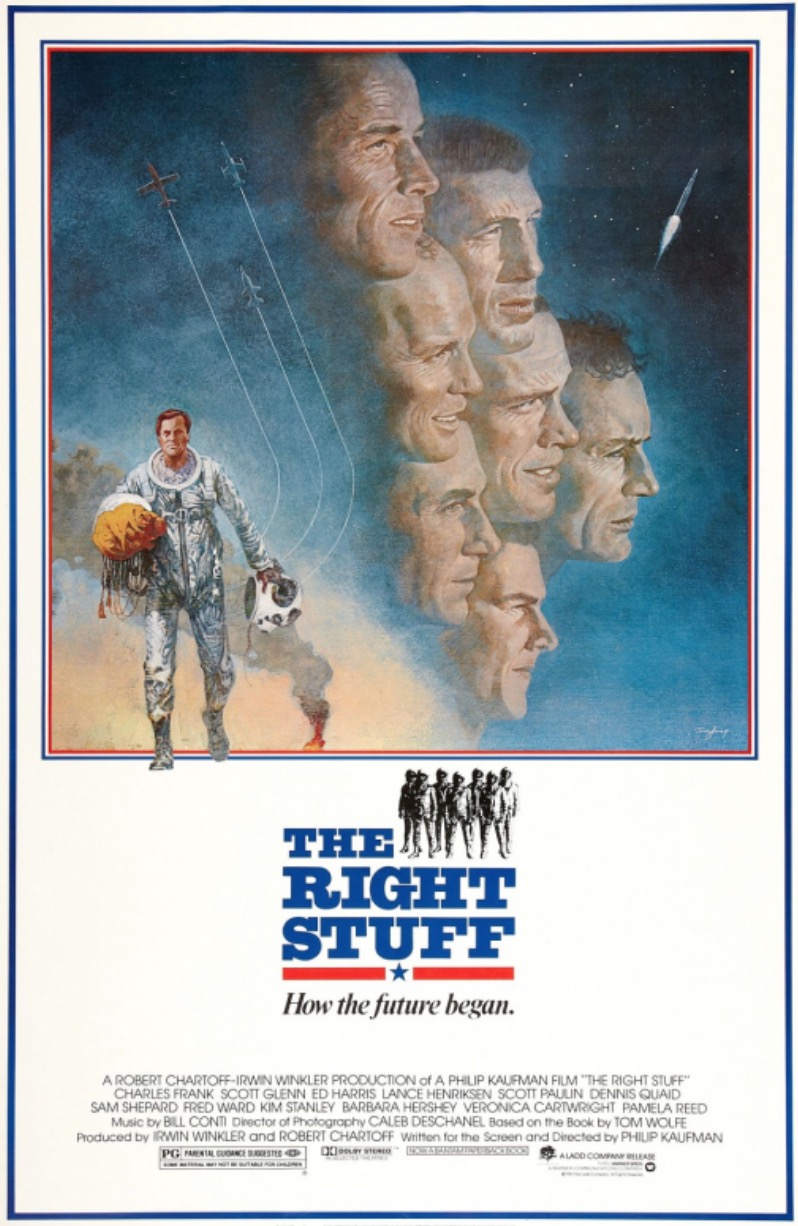 ROTTER: You can always figure out a solution if you spend enough time working on it and just never give up. That was the thing about Dede — she never gave up on anything and she passed that on to all those who ever worked for her.
ROTTER: You can always figure out a solution if you spend enough time working on it and just never give up. That was the thing about Dede — she never gave up on anything and she passed that on to all those who ever worked for her.
HULLFISH: I am interested in your documentary background. Do you find that there’s a lot of overlap in skill set or is there something that you learned from documentary that you carried into features?
ROTTER: The thing about documentaries — editorially you’re finding the story which is totally different from narrative material when the story is there and you’re implementing it. So in many ways, documentary skills are not about actually putting the film together but about creating what that film is about.
You’re one of the architects of that movie. So in some instances, your contribution is more important to the film than the editor is to narrative material.
I do notice that documentaries — now that COVID has hit — are becoming a lot more popular and a lot more money is being spent on them as opposed to ten years ago when — aside from Ken Burns — the form was almost dead.
HULLFISH: Have you ever worked on a film that needed massive restructuring?
ROTTER: No. The reason for massive restructuring is that the script just isn’t working. I’m sure that there have been a few times that I’ve juxtaposed a couple of scenes but I wouldn’t call it massive restructuring.
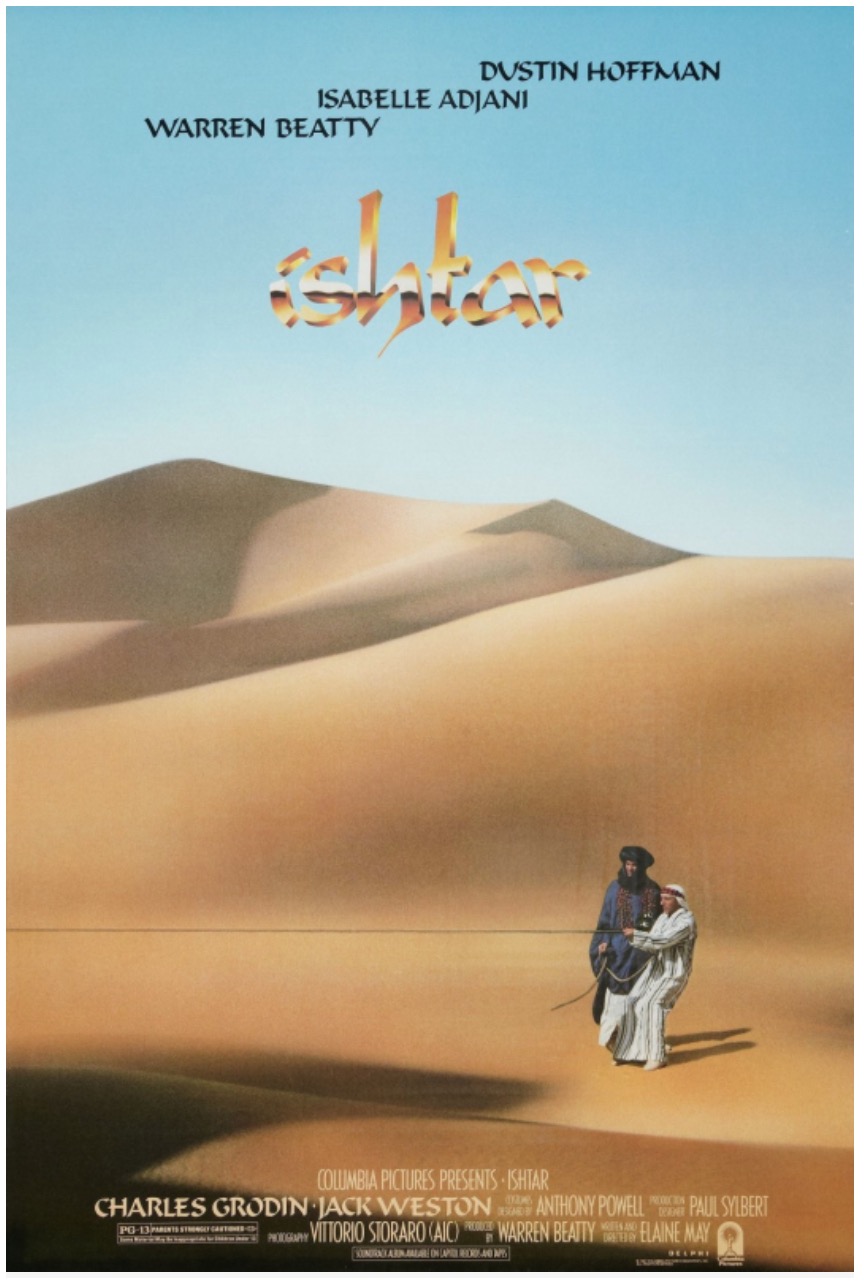 The one movie that I did that is notorious is Ishtar, which now is sort of making a comeback.
The one movie that I did that is notorious is Ishtar, which now is sort of making a comeback.
It was definitely an interesting time working with that cast of characters and has some moments in it that I thought were extremely funny. Usually, it’s mentioned in derogatory terms.
HULLFISH: Do you think that was because of the financial issues?
ROTTER: I think that our producer and the head of Columbia at that time who had just taken over — David Putnam — and Warren Beatty, didn’t like each other. So I don’t think it was high on their list of releases. And of course the money made a difference. Once the trade press gets hold of a story about a project that’s not going the way you want it to, it seems to catch like wildfire.
But if you watch the movie, there are things in it that are just totally unique and never been done before. And so Elaine (director Elaine May), who is an absolutely brilliant director, suffered professionally from the arrows of scorn that were pointed her way, but she’s really one of the great artists of our times, not only for her moviemaking but also for her writing.
Somehow I managed to survive — as all the other people did. So it just goes to prove that when you get hammered, stick your head up again, maybe they’ll miss the next time.
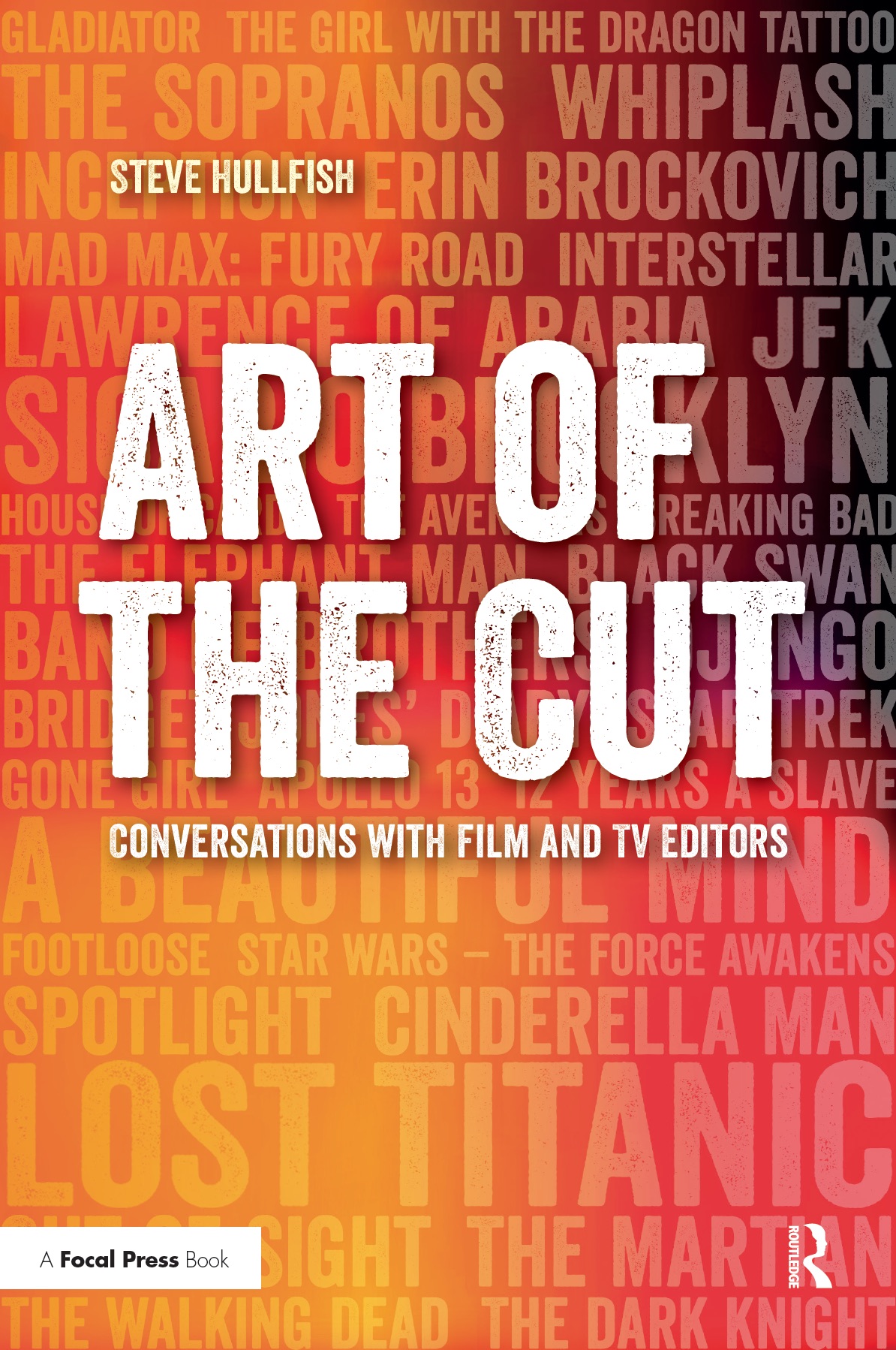 HULLFISH: Great advice to end on.
HULLFISH: Great advice to end on.
From one Steve to another, thank you so much for joining me.
ROTTER: Thanks a lot. My pleasure. Bye.
To read more interviews in the Art of the Cut series, check out THIS LINK and follow me on Twitter @stevehullfish or on imdb.
The first 50 interviews in the series provided the material for the book, “Art of the Cut: Conversations with Film and TV Editors.” This is a unique book that breaks down interviews with many of the world’s best editors and organizes it into a virtual roundtable discussion centering on the topics editors care about. It is a powerful tool for experienced and aspiring editors alike. Cinemontage and CinemaEditor magazine both gave it rave reviews. No other book provides the breadth of opinion and experience. Combined, the editors featured in the book have edited for over 1,000 years on many of the most iconic, critically acclaimed, and biggest box office hits in the history of cinema.

Filmtools
Filmmakers go-to destination for pre-production, production & post production equipment!
Shop Now